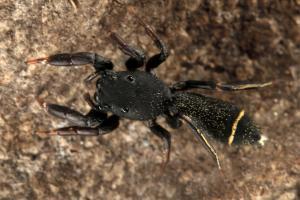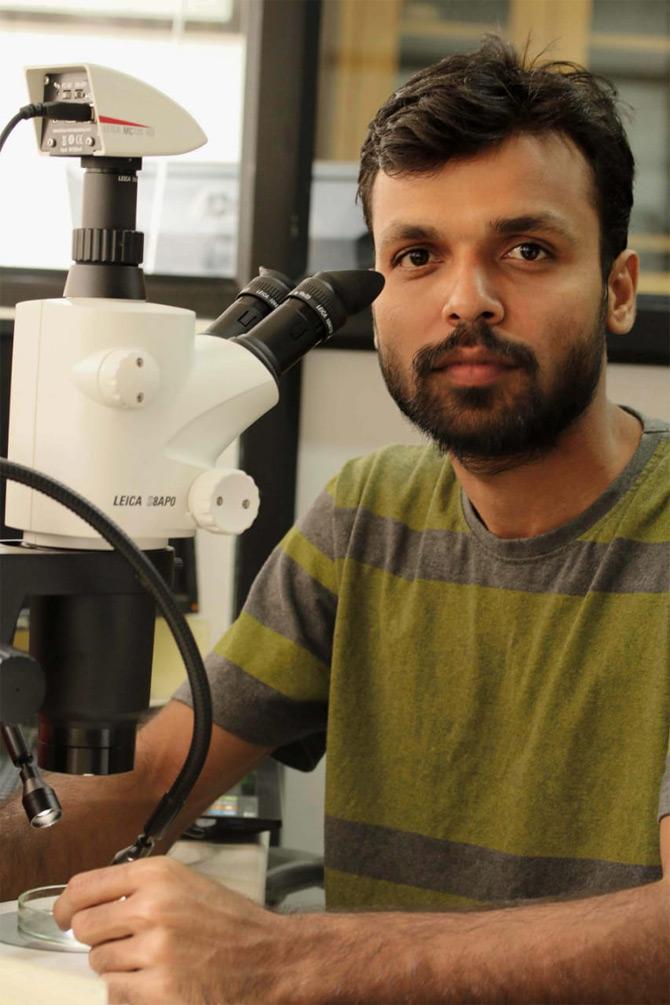The jumping spider family (Salticidae) is the most diverse spider family, with their world fauna consisting of 6126 described species. It has been named after Senior IFS officer Sunil Limaye the Additional Principal Chief Conservator of Forest APCCF

The jumping spider that was discovered by the team from Aarey Colony. Pic./Rajesh Sanap
In what can be termed as an important discovery from Mumbai, a new jumping spider species has been discovered from Aarey Milk Colony once again highlighting the fact that the area has a rich biodiversity and the need of the hour is to protect the forested patch in the area. The species has been named after Senior IFS officer Sunil Limaye the Additional Principal Chief Conservator of Forest APCCF; Wildlife who during his tenure as the Chief Conservator of Forest of SGNP had started the Mumbaikars for SGNP project.

Senior IFS Officer Sunil Limaye
The study was carried out by a team of arachnologists including Rajesh Sanap, Archaeologist Dr. John Caleb T.D and Biologist Anuradha Joagalekar. With the new discovery of jumping spider from Aarey, Wildlife Lovers and green activists have once again demanded that the Aarey Milk Colony forest needs to be protected from unplanned development and illegal encroachments that are eating into the green space of the one the most important green space of Mumbai.
According to Sanap who has discovered several species from Aarey, the jumping spider family (Salticidae) is the most diverse spider family, with their world fauna consisting of 6126 described species. These tiny creatures can be easily recognised by their lager anterior median eyes. They are diurnal hunters and possess brilliant vision and swift reflexes. In India, there are about 256 species of jumping spiders known till date. In fact, the total diversity of jumping spiders represented from India is greatly understated compared with that from other regions. For example, countries like Australia, Brazil, and China are represented by a diversity of more than 450 species each. There is, therefore, a great diversity in India still waiting to be uncovered, which needs to be discovered and conserved before it is lost forever.

Rajesh Sanap
"The new species belongs to the hisponine jumping spider genus Jerzego, which was established by Maddison in 2014. The genus currently comprises three described species in the world. Of these, only one species is known from the Indian subcontinent (India and Sri Lanka). Two other species are known from Southeast Asia from Sumatra and Borneo. All three species were described based either on immature females or both males and females, but no details of their natural history were reported. Jerzego sunillimaye is the first ever species of this genus whose taxonomic details, mating behavior and egg development have been documented. The observations are supported by excellent digital images of the spider in life," said Archaeologist Sanap.
Species: 'Jerzego sunillimaye'
The researcher, after carefully studying its feature form photographs and published papers and discussing with experts, arrived to a conclusion that this is the new species. :
"Initially, species identification was challenging since we had data on females only. So we planned another survey and found two males. After a comprehensive examination, we notice that the morphology of this species closely resembled that of a Southeast Asian species, J. corticicola, which was described from Borneo in 2014. Hence, we placed this species tentatively under the same genus. Jerzego sunillimaye can be easily distinguished from other known species by the larger body size (Females, 10.30 mm) and a different colour pattern on the abdomen. A transverse crescent-shaped golden–yellow stripe is present in the posterior half of the abdomen. The males (5.52 mm) can be readily distinguished by their unique genitalia (palps) with a flattened and twisted embolus. " added Sanap.

Archaeologist Dr. John Caleb T.D
"It should be noted that the new species Jerzego sunillimaye was found for the first time in 2016 during a survey in the unique, eco-sensitive, dry-deciduous habitat of Aarey Milk Colony in Mumbai. The research was carried out for almost 3 years to understand the natural history of this species. Within this period, we reported some interesting observations, which have never been documented before."
In this research, the researchers explored different habitats such as grasslands and rocky and forested patches to find out the habitat these tiny spiders preferred. These spiders were found in areas covered with a thick canopy, largely dominated by trees, such as Mangifera indica, Adenanthera sp., Acacia auriculiformis, and Anacardium occidentale. The forest floor was covered with dry leaf litter, and the habitat was shared by other jumping spiders such as Hasarius sp., Stenaelurillus sp., Langelurillus sp., and Langona sp. Several males and females of various life stages were observed throughout the years. Specifically, in monsoon, females were observed guarding their egg sacs, while males were observed wandering under the rocks. There were variations in vegetation cover in the landscape during summer and monsoon. In winter and summer, spiders were mostly found on the underside of rocks, in dry leaf litter, or sometimes under tree barks close to the ground; most sub-adults were ground dwelling. The sub-adults of the species appeared like ants. Interestingly, four to five sub-adults were observed in close proximity with small brown ants of the genus Crematogaster. Two to three adult females with egg sacs were observed under rock surfaces and were surrounded by small black ants of the genus Paratrechina. However, there is no evidence to suggest a mimetic relationship with these ants and further behavioral studies are warranted.

Anuradha Joglekar
Speaking to mid-day Biologist Anuradha Joglekar said, "Aarey Milk Colony has constantly been in the limelight for the discovery of several new species of spiders and scorpions. The vegetation structure is particularly undisturbed and is home to several interesting species. Aarey Milk Colony is also home to other enigmatic jumping spiders such as Langelurillus onyx and Langelurillus lacteus, both described in 2017. Piranthus decoruswas also recorded for the first time in 122 years from the same location. More studies pertaining to their complete biology, habits, and interactions with other species are yet to be carried out. Moreover, their conservation status has not been assessed yet because of lack of information on their population status, distribution, ecology, and biology."
Spiders are microhabitat specialists and are highly sensitive to minuscule changes in their immediate environment. Habitat loss due to anthropogenic activities (encroachment and degradation of forests) is the main concern. The recent discovery of several new species from this region adds to the pressing need for conservation of this particular region, which may harbor much more undiscovered life.

Jumping spider. Pic/Rajesh Sanap
About IFS Officer Sunil Limaye:
Senior IFS Officer Sunil Limaye was a former Director and Chief Conservator of Forest (CCF) of Sanjay Gandhi National Park(SGNP) and has been involved in the conservation of urban biodiversity in Mumbai and the neighboring areas. He is also the same officer who started the Mumbaikars for SGNP project in SGNP along with Biologist and Leopard Expert Dr. Vidya Athreya. The MfSGNP project which has seen involvement and participation of various stakeholders like people staying on the periphery of the park, BMC officers/Police officers /Schools has been a successful model which is being replicated in other states including Uttarakhand /UP too. As a part of the project, awareness sessions among various stakeholders related to Human-Leopard interactions are being done on the periphery of the park and people are being taught the measures that they should take to prevent man-animal conflicts.
Catch up on all the latest Crime, National, International and Hatke news here. Also download the new mid-day Android and iOS apps to get latest updates
 Subscribe today by clicking the link and stay updated with the latest news!" Click here!
Subscribe today by clicking the link and stay updated with the latest news!" Click here!









